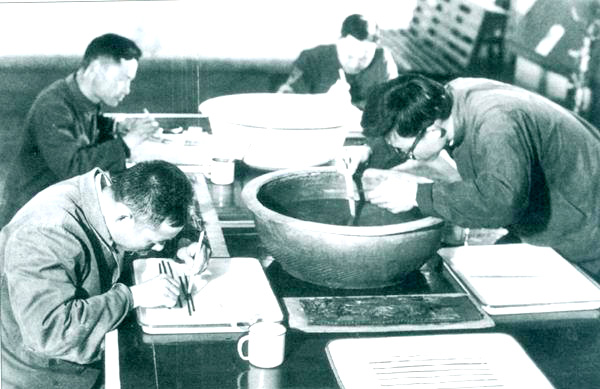History recorded on bamboo

The archaeologists are sorting and restoring the Yinqueshan Han slips. Photo: YINQUESHAN HAN TOMBS BAMBOO SLIPS MUSEUM
The discovery of the Yinqueshan Han Slips in 1972 shocked the world. In 2015, led by the Chinese Academy of Cultural Heritage and Shandong Museum, a group of academic institutions restarted a research program examining them.
Discovery of the Yinqueshan Han Slips
The Yinqueshan Han slips were discovered in two ancient tombs dated to the early Western Han Dynasty (202 BCE–8 CE), located southeast of Linyi in Shandong Province. A large number of bamboo slips and their fragments were excavated from the tombs, together with some fragments of lacquer, pottery, bronzeware and coins. “After cleaning and sorting, there were over 7,500 bamboo slips that have been unearthed from the Han tombs,” said Peng Mei, deputy director of the Yinqueshan Han Tombs Bamboo Slips Museum.
The slips discovered in Tomb No. 1 include 13 chapters and five undetermined chapters from the Sunzi Bingfa (also known as The Art of War by Sun Tzu, one of the best-known ancient military treatises in the world), 16 chapters from the Sunbin Bingfa (also known as The Art of War by Sun Bin, an essential text of Chinese military philosophy and of strategy in general), five chapters from the Wei Liaozi (one of the Seven Military Classics of ancient China written during the Warring States Period), 16 chapters from the Yanzi Chunqiu (or the Annals of Master Yan, a text dating to the Warring States Period that contains a collection of stories and speeches attributed to Yan Ying, a famous official from the State of Qi), seven original and seven undetermined chapters from the Liu Tao (or the Six Secret Teachings, a treatise on civil and military strategy traditionally attributed to Lü Shang, a top general of the Zhou Dynasty), 13 chapters represented by the Shou Fa (uphold the law) and Shou Ling (keep order), 50 chapters about discourses on politics and wars and some writings of Yin Yang and divination. 32 slips unearthed from Tomb No. 2 have been identified as the Qinian Shiri, representing sections of a calendar for the year 134 BCE, which is the oldest calendar ever found in China.
Wu Jiulong, a research fellow from the Institute of Chinese Cultural Relics of the National Cultural Heritage Administration, took part in the first archaeological excavation and research expedition. He recalled details of these bamboo slips when they were excavated. “Because they were immersed in mud and squeezed by other funeral objects for a long time, the thread that sewed the bamboo slips together has rotted, leaving dark brown slips scattered everywhere. However, most of the handwritings on these slips were clear to see. Each slip recorded various amounts of ancient Chinese characters, with some including as many as 40 characters.”
“Immersion in groundwater and the airtight tombs provide good preservation conditions for these bamboo slips, helping them survive more than 2,000 years,” said Wei Songtao, a staff member of Shandong Museum. However, there is little cellulose left. These bamboo slips are as soft as noodles or rotten straw, almost unable to withstand any treatment. A large proportion of the existing slips are fragments.
Cataloguing and restoration of slips
After the discovery of the Yinqueshan slips, the National Cultural Heritage Administration conducted the preservation and research work on these relics. Wei Songtao stated that, considering the limited technology of cultural relics preservation at that time, archaeologists chose a safe way to preserve these slips—dehydrating a few slips for trial and storing most of them in distilled water.
The restoration and sorting of these bamboo slips was a big challenge. A lot of parts were missing and many characters became unintelligible from prolonged immersion. In 1974, a special team was organized to undertake restoration work. The team consisted of many famous experts from fields of archaeology, history, bibliography and the study of ancient Chinese writing.
Pian Yuqian, a senior editor at the Editorial Department of Zhonghua Book Company, participated in the cataloguing and restoration of those bamboo sheets when he was a student at Peking University. He recalled that the first step was to catalogue the 4,000 slips according to their types, putting the slips with similar types in one group. The next step was to classify slips within the same group according to their calligraphy and styles. Finally, slips of similar calligraphy and styles were grouped by their contents. The process of grouping the slips together by their forms, calligraphy and content was challenging and required great patience.
After the aforementioned process, the experts studied the content of the slips within the same group, identifying which text they belonged to and arranging them in sequence. After that, the whole procedure of the classification of bamboo slips was followed by archeologists and other research staff.
(edited by REN GUANHONG)
